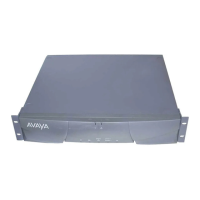TIE-TRK (Analog Tie Trunk)
Issue 1 May 2002
8-1639555-233-143
A tie trunk port can also be administered as an access endpoint which is a
non-signaling channel with a voice-grade data bandwidth. Tie trunk maintenance
employs up to 6 tests, depending on the hardware involved, to monitor the
operating condition of the trunk and its connections. These are described in the
following sections on each test. The port must be idle for these tests to run. If an
incoming call seizes the port while a test is in progress, the test aborts and the call
proceeds (except for TN497).
Additional in-line testing is performed whenever a call is in progress, logging
errors that occur during operation. You can reproduce these types of errors by
making a call over the trunk and then checking the Hardware Error Log.
By making translation and cross-connect changes, circuit packs (except for
TN497) can be configured for back-to-back testing, also known as connectivity
testing. Port operation is tested by connecting two tie trunk ports together in
either E&M or simplex modes. See the section ‘‘Analog Tie Trunk Back-to-Back
Testing’’ on page 5-26.
Error Log Entries and Test to Clear Values
Table 8-637. TIE Trunk Error Log Entries
Error
Type
Aux
Data Associated Test Alarm Level
On/Off
Board Test to Clear Value
0
1
0Any Any Anytest port UUCSSpp sh r 1
1(a) 16384 None WARNING OFF
1(b) 57476 None WARNING OFF
1(c) 57477 None WARNING OFF
1(d) 57483 None WARNING OFF
1(e) 57485 None WARNING OFF
15(f) Any Port Audit Update test
(#36)
18(g) 0 busyout trunk grp/mbr WARNING OFF release trunk grp/mbr
130(h) None WARNING ON test trunk grp/mbr
257(i) 57473 None WARNING OFF
257(j) 57474 None WARNING OFF
257(k) 57475 None WARNING OFF
513(l) Any EPF M and E Lead (#74) MAJOR
MINOR
WARNING
2
OFF test port UUCSSpp sh r 3
Continued on next page

